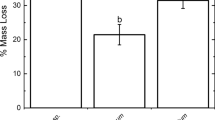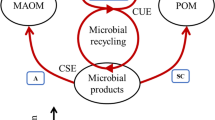Abstract
Although methanogenic pathways generally produce equimolar amounts of carbon dioxide and methane, CO2 concentrations are often reported to be higher than CH4 concentrations in both field and laboratory incubation studies of peat decomposition. In field settings, higher pore water concentrations of CO2 may result from the loss of methane by: (1) ebullition due to the low solubility of methane in pore water and (2) vascular-plant transport. Higher CO2 concentrations may also be caused by: (1) production of additional CO2 by high-molecular weight (HMW) organic matter (OM) fermentation and/or (2) respiration from non-methanogenic pathways. In this study of a peatland where advection and transverse dispersion were the dominant pore water solute transport mechanisms, an isotope-mass balance approach was used to determine the proportions of CO2 formed from non-fractionating OM respiration and HMW fermentation relative to CO2 production from methanogenesis. This approach also allowed us to estimate the loss of CH4 from the belowground system. The pathways of CO2 production varied with depth and surface vegetation type. In a Carex-dominated fen, methane production initially produced 40 % of the total CO2 and then increased to 90–100 % with increasing depth. In a Sphagnum-dominated bog, methanogenesis resulted in 60 % of total CO2 production which increased to 100 % at depth. Both bogs and fens showed 85–100 % of methane loss from pore waters. Our results indicate that the isotopic composition of dissolved CO2 is a powerful indicator to allow partitioning of the processes affecting peat remineralization and methane production.







Similar content being viewed by others
References
Aller RC (1998) Mobile deltaic and continental shelf muds as suboxic, fluidized bed reactors. Mar Chem 61:143–155. doi:10.1016/S0304-4203(98)00024-3
Armstrong W, Cousins D, Armstrong J, Turner DW, Beckett PM (2000) Oxygen distribution in wetland plant roots and permeability barriers to gas-exchange with the rhizosphere: a microelectrode and modelling study with Phragmites australis. Ann Bot 86:687–703
Barker HA (1936) On the biochemistry of methane formation. Arch Microbiol 7(1–5):404–419. doi:10.1007/BF00407413
Blodau C, Roehm CL, Moore TR (2002) Iron, sulfur, and dissolved carbon dynamics in a northern peatland. Arch Hydrobiol 154(4):561–583
Bridgham SD, Johnston CA, Pastor J, Updegraff K (1995) Potential feedbacks of northern wetlands on climate change. Bioscience 45(4):262–274
Burdige DJ (2002) Sediment pore waters. In: Hansell DA, Carlson CD (eds) Biogeochemistry of marine dissolved organic matter. Academic Press, San Diego, pp 611–663
Burdige DJ (2006) Geochemistry of marine sediments. Princeton University Press, Princeton, pp 421–424
Canfield DE (1994) Factors influencing organic matter preservation in marine sediments. Chem Geol 114(3–4):315–329. doi:10.1016/0009-2541(94)90061-2
Chanton JP (2005) The effect of gas transport mechanism on the isotope signature of methane in wetlands. Org Geochem 36(5):753–768
Chanton JP, Martens CS (1988) Seasonal variations in ebullitive flux and carbon isotopic composition of methane in a tidal freshwater estuary. Glob Biogeochem Cycl 2:289–298
Chanton JP, Bauer JE, Glaser PA, Siegel DI, Kelley CA, Tyler SC, Romanowicz EH, Lazrus A (1995) Radiocarbon evidence for the substrates supporting methane formation within northern Minnesota peatlands. Geochim Cosmochim Acta 59(17):3663–3668
Chanton JP, Chasar L, Glaser PH, Siegel DI (2005) Carbon and hydrogen isotopic effects in microbial methane from terrestrial environments. In: Flanagan LB, Ehleringer JR, Pataki DE (eds) Stable isotopes and biosphere–atmosphere interactions, physiological ecology series. Elsevier, Amsterdam, pp 85–105
Chanton JP, Glaser PH, Chasar LS, Burdige DJ, Hines ME, Siegel DI, Tremblay LB, Cooper WT (2008) Radiocarbon evidence for the importance of surface vegetation on fermentation and methanogenesis in contrasting types of boreal peatlands. Glob Biogeochem Cycl 22:GB4022. doi:10.1029/2008GB003274
Chasar LS, Chanton JP, Glaser PH, Siegel DI (2000a) Methane concentration and stable isotope distribution as evidence of rhizospheric processes: comparison of a fen and bog in the Glacial Lake Agassiz Peatland Complex. Ann Bot 86:655–663
Chasar LS, Chanton JP, Glaser PH, Siegel DI, Rivers JS (2000b) Radiocarbon and stable carbon isotopic evidence for transport and transformation of dissolved organic carbon, dissolved inorganic carbon and CH4 in a northern Minnesota Peatland. Glob Biogeochem Cycl 14(4):1095–1108
Chason DB, Siegel DI (1986) Hydraulic conductivity and related physical properties of peat, Lost River Peatland, northern Minnesota. Soil Sci 142(2):91–99
Colmer TD (2003) Long-distance transport of gases in plants: a perspective on internal aeration and radial oxygen loss from roots. Plant Cell Environ 26:17–36
Conrad R (1999) Contribution of hydrogen to methane production and control of hydrogen concentrations in methanogenic soils and sediments. FEMS Microbiol Ecol 28:193–202
D’Andrilli J, Chanton JP, Glaser PH, Cooper WT (2010) Characterization of dissolved organic matter in northern peatland soil pore waters by ultra high resolution mass spectrometry. Org Geochem 41:791–799
Fenner N, Freeman C (2011) Drought-induced carbon loss in peatlands. Nat Geosci 4:895–900
Freeman C, Evans CD, Monteith DT, Reynolds B, Fenner N (2001) Export of organic carbon from peat soils. Nature 412:785
Glaser PH (1987) The development of streamlined bog islands in the continental interior of North America. Arct Alp Res 19(4):402–413
Glaser PH, Wheeler GA, Gorham E, Wright HE Jr (1981) The patterned mires of the Red Lake Peatland, northern Minnesota: vegetation, water chemistry and landforms. J Ecol 69(2):575–599
Glaser PH, Siegel DI, Romanowicz EA, Shen YP (1997) Regional linkages between raised bogs and the climate, groundwater, and landscape of north-western Minnesota. J Ecol 85(1):3–16
Glaser PH, Chanton JP, Morin P, Rosenberry DO, Siegel DI, Ruud O, Chasar LI, Reeve AS (2004) Surface deformations as indicators of deep ebullition fluxes in a large northern peatland. Glob Biogeochem Cycl 18:GB1003. doi:10.1029/2003GB002069
Glaser PH, Siegel DI, Reeve AS, Chanton JP (2006) The hydrology of large peat basins in North America. In: Martini IP, Martinez CA, Chesworth W (eds) Peatlands: basin evolution and depository of records on global environmental and climatic changes. Elsevier, Amsterdam
Gorham E (1991) Northern Peatlands: role in the carbon cycle and probable responses to climatic warming. Ecol Appl 1(2):182–195
Gorham E, Hofstetter RH (1971) Penetration of bog peats and lake sediments by tritium from atmospheric fallout. Ecology 52(5):898–902
Hines ME, Duddleston KN, Rooney-Varga J, Fields D, Chanton JP (2008) Uncoupling of acetate degradation from methane formation in Alaskan wetlands: connections to vegetation distribution. Glob Biogeochem Cycl 22:GB2017. doi:10.1029/2006GB002903
Hornibrook ERC, Longstaffe FJ, Fyfe WS (1997) Spatial distribution of microbial methane production pathways in temperate zone wetland soils: stable carbon and hydrogen isotope evidence. Geochim Cosmochim Acta 61(4):745–753
Hornibrook ERC, Longstaffe FJ, Fyfe WS (2000) Evolution of stable carbon isotope compositions for methane and carbon dioxide in freshwater wetlands and other anaerobic environments. Geochim Cosmochim Acta 64(6):1013–1027
Keller JK, Bridgham SD (2007) Pathways of anaerobic carbon cycling across an ombrotrophic–minerotrophic peatland gradient. Limnol Oceanogr 52(1):96–107
Knapp AK, Yavitt JB (1992) Evaluation of a closed-chamber method for estimating methane emissions from aquatic plants. Tellus 44B:63–71
Kusel K, Blothe M, Schulz D, Reiche M, Drake HL (2008) Microbial reduction of iron and pore water biogeochemistry in acidic peatlands. Biogeosciences 5:1537–1549
Lapham L, Proctor L, Chanton JP (1999) Using respiration rates and stable carbon isotopes to monitor the biodegradation of Orimulsion by marine benthic bacteria. Environ Sci Technol 33:2035–2039
Limpens J, Berendse F, Blodau C, Canadell JG, Freeman C, Holden J, Roulet N, Rydin H, Schaepman-Strub G (2008) Peatlands and the carbon cycle: from local processes to global implications—a synthesis. Biogeosci Discuss 5:1379–1419
Lovley DR, Coates JD, Blunt-Harris EL, Phillips EJP, Woodward JC (1996) Humic substances as electron acceptors for microbial respiration. Nature 382:445–448
Moore TR, Roulet NT, Waddington JM (1998) Uncertainty in predicting the effect of climatic change on the carbon cycling of Canadian peatlands. Clim Change 40:229–245
Parsekian AD, Comas X, Slater L, Glaser PH (2011) Geophysical evidence for the lateral distribution of free phase gas at the peat basin scale in a large northern peatland. J Geophys Res 116:G03008. doi:10.1029/2010JG001543
Popp TJ, Chanton JP, Whiting GJ, Grant N (2000) Evaluation of methane oxidation in the rhizosphere of a Carex dominated fen in north central Alberta, Canada. Biogeochemistry 51:259–281
Post WM, Emanuel WR, Zinke PJ, Stangenberger AG (1982) Soil carbon pools and world life zones. Nature 298:156–159
Post WM, Pastor J, Zinke PJ, Stangenberger AG (1985) Global patterns of soil nitrogen storage. Nature 317:613–616
Reeve AS, Siegel DI, Glaser PH (2000) Simulating vertical flow in large peatlands. J Hydrol 227:207–217
Rivers JS, Siegel DI, Chasar LS, Chanton JP, Glaser PH, Roulet NT, McKenzie JM (1998) A stochastic appraisal of the annual carbon budget of a large circumboreal peatland, Rapid River Watershed, northern Minnesota. Glob Biogeochem Cycl 12(4):715–727
Romanowicz EA, Siegel DI, Glaser PH (1993) Hydraulic reversals and episodic methane emissions during drought cycles in mires. Geology 21:231–234
Romanowicz EA, Siegel DI, Chanton JP, Glaser PH (1995) Temporal variations in dissolved-methane deep in the Lake Agassiz Peatlands, Minnesota. Glob Biogeochem Cycl 9(2):197–212
Shoemaker JK, Schrag DP (2010) Subsurface characterization of methane production and oxidation from a New Hampshire wetland. Geobiology 8:234–243
Shoemaker JK, Schrag DP (2011) Does methanogenesis require oxygen? In: Abstract presented at 2011 fall meeting. AGU, San Francisco, 5–9 Dec
Siegel DI (1983) Ground water and the evolution of patterned mires, Glacial Lake Agassiz Peatlands, northern Minnesota. J Ecol 71(3):913–921
Siegel DI, Glaser PH (1987) Groundwater flow in a bog–fen complex, Lost River Peatland, northern Minnesota. J Ecol 75(3):743–754
Tarvin D, Buswell AM (1934) The methane fermentation of organic acids and carbohydrates. J Am Chem Soc 56(8):1751–1755
Tfaily MM, Hamdan R, Corbett JE, Chanton JP, Glaser PH, Cooper WT (in press) Studies of dissolved organic matter reactivity in the Glacial Lake Agassiz Peatlands of northern Minnesota using Fourier transform ion cyclotron resonance mass spectrometry and excitation-emission matrix fluorescence spectroscopy. Geochim Cosmochim Acta
Valentine DW, Holland EA, Schimel DS (1994) Ecosystem and physiological controls over methane production in northern wetlands. J Geophys Res 99(D1):1563–1571
Vile MA, Bridgham SD, Wieder RK (2003a) Response of anaerobic carbon mineralization rates to sulfate amendments in a boreal peatland. Ecol Appl 13(3):720–734
Vile MA, Bridgham SD, Wieder RK, Novák M (2003b) Atmospheric sulfur deposition alters pathways of gaseous carbon production in peatlands. Glob Biogeochem Cycl 17(2):1058. doi:10.1029/2002GB001966
Whiticar MJ (1999) Carbon and hydrogen isotope systematics of bacterial formation and oxidation of methane. Chem Geol 161:291–314
Whiticar MJ, Faber E, Schoell M (1986) Biogenic methane formation in marine and freshwater environments: CO2 reduction vs. acetate fermentation—isotope evidence. Geochim Cosmochim Acta 50:693–709
Whiting GJ, Chanton JP (1992) Plant-dependent CH4 emissions in a subarctic Canadian fen. Glob Biogeochem Cycl 6(3):225–231
Wieder RK, Linton MN, Heston KP (1990) Laboratory mesocosm studies of Fe, Al, Mn, Ca, and Mg dynamics in wetland exposed to synthetic acid coal mine drainage. Water Air Soil Pollut 51:181–196
Wright EL, Black CR, Cheesman AW, Drages T, Larges D, Turner BL, Sjogersten S (2011) Contribution of subsurface peat to CO2 and CH4 fluxes in a neotropical peatland. Glob Change Biol 17:2867–2881
Yavitt JB, Lang GE (1990) Methane production in contrasting wetland sites: response to organic-chemical components of peat and to sulfate reduction. Geomicrobiol J 8(1):27–46
Yu Z, Loisel J, Brosseau DP, Beilman DW, Hunt SJ (2010) Global peatland dynamics since the Last Glacial Maximum. Geophys Res Lett 37:L13402. doi:10.1029/2010GL043584
Acknowledgments
This research was supported by the National Science Foundation, EAR-0628349 and DEB 0841158. Conversations and interactions with Patrick Crill, Neal Blair, Scott Bridgham, Don Siegel, Lee Slater, Andrew Reeve, Xavier Comas, Juliana D’Andrilli, Mimi Sarkar and especially Julie Shoemaker improved this work. We thank Dr. Kelman Weider and two anonymous reviewers for their helpful comments.
Author information
Authors and Affiliations
Corresponding author
Rights and permissions
About this article
Cite this article
Corbett, J.E., Tfaily, M.M., Burdige, D.J. et al. Partitioning pathways of CO2 production in peatlands with stable carbon isotopes. Biogeochemistry 114, 327–340 (2013). https://doi.org/10.1007/s10533-012-9813-1
Received:
Accepted:
Published:
Issue Date:
DOI: https://doi.org/10.1007/s10533-012-9813-1




